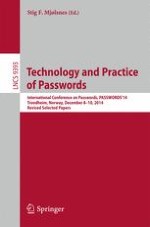2015 | Book
Technology and Practice of Passwords
International Conference on Passwords, PASSWORDS'14, Trondheim, Norway, December 8-10, 2014, Revised Selected Papers
Editor: Stig F. Mjølsnes
Publisher: Springer International Publishing
Book Series : Lecture Notes in Computer Science
